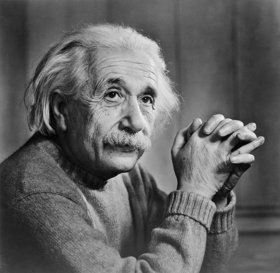|
Name: Einstein Born: March 14, 1879 Died: April 18, 1955 Location: Germany/America What he did: Theoretical physicist |
"God does not play dice" "When a guy sits with a hot chic for an hour, it seems like a minute. But let him sit on a hot stove for a minute and it's longer than any hour. Now that's relativity, boys and girls!" |
Einstein's theory: The presence of matter "warps" space-time. objects in free fall in the universe take geodesics (counterpart of a straight line in Euclidean geometry) in space-time. therefore gravity is affected by two components:
Curvature of spaceThe effect of this is so little it can be ignored in all cases when:
A good image is to think of a weight of a massive object which stretches the trampoline-like space-time fabric, which results in trajectories around this dent being curved due to the slope and the pull of gravity. Curvature of space explains why mercury is the closest planet to the sun, and moves faster than any other planet, but also is more curved that any other planet. |
Time dilationTime dilation is the slowing down of the passage of time experienced by people or objects in relation to the observer. This effect is so significant that Global Positioning System (GPS) need to correct with respect to the effects of time dilation. The effect is extremely small until speed approaches 30,000kmph (1/10 the speed of light) Lorentz factor - Behind the calculations for Time dilation
Basically, the nature of the universe must not change for an observer if their inertial state changes. The speed of light is the same to all inertial observers, is the same in all directions, and does not depend on the velocity of the object emitting the light. |

